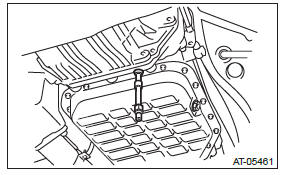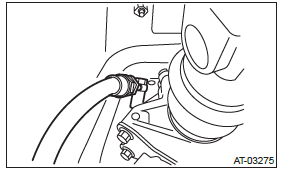Subaru Outback (BR): Road Test with Automatic Transmission
A: INSPECTION
1. GENERAL PRECAUTION
Road tests should be conducted to properly diagnose the condition of automatic transmission.
NOTE: When performing the test, do not exceed posted speed limit.
2. D RANGE SHIFT FUNCTION
Check shifting between 1st ←→ 2nd ←→ 3rd ←→ 4th ←→ 5th while driving on normal city streets.
3. D RANGE SHIFT SHOCK
Check the shock level when shifting up during normal driving.
4. KICK-DOWN FUNCTION
Check kick-down for each gear. Check the shock level during kick-down at the same time.
5. ENGINE BRAKE OPERATION
- Check the 4th gear engine brake when shifting down from 5th to 4th range while driving in 5th gear of manual mode [50 to 60 km/h (31 to 37 MPH) ].
- Check the 3rd gear engine brake when shifting down from 4th to 3rd range while driving in 4th gear of manual mode [50 - 60 km/h (31 - 37 MPH) ].
- Check the 2nd gear engine brake when shifting down from 3rd to 2nd range while driving in 3rd gear of manual mode [40 - 50 km/h (25 - 31 MPH) ].
- Check the 1st gear engine brake when shifting down from 2nd to 1st range while driving in 2nd gear of manual mode [20 - 30 km/h (12 - 19 MPH) ].
6. LOCK-UP FUNCTION
When the accelerator is lightly depressed while driving on a flat road in lock-up range, check that rpm does not change abruptly.
7. P RANGE OPERATION
Stop the vehicle on an uphill grade of 5% or more and shift to the "P" range. Check that the vehicle does not move when the parking brake is released.
8. NOISE AND VIBRATION
Check for noise and vibration while driving and during shifting.
9. OIL LEAKAGE
After the driving test, inspect for oil leaks from the transmission body.
Stall Test
A: INSPECTION
NOTE: The stall test is extremely important in diagnosing the condition of an automatic transmission and engine.
The test is necessary to measure the engine stall speeds in "2nd gear of manual mode".
Purposes of the stall test:
- Operational check of the automatic transmission clutch
- Operational check of the torque converter clutch
- Engine performance check
1) Check that the throttle valve fully opens.
2) Check that the engine oil level is correct.
3) Check that the coolant level is correct.
4) Check that the ATF level is correct.
5) Check that the differential gear oil level is correct.
6) Raise the ATF temperature to 70 to 80ºC (158 to 176ºF) by driving a distance of 5 to 10 km (3 to 6 miles).
Confirm the ATF temperature on Subaru Select Monitor. <Ref. to 5AT(diag)-18, Read Current Data.>
7) Place the wheel chocks at the front and rear of all wheels and apply the parking brake.
8) Move the select lever to ensure it operates properly, then set to "2nd gear of manual mode".
9) While stepping hard on the brake pedal, gradually step on the accelerator pedal.
10) When the engine speed is stabilized, quickly record the engine speed and release accelerator pedal.
11) Shift the select lever to "N" range, and cool down the engine by idling it for one minute or more.
NOTE:
- Do not perform a stall test for over 5 seconds at a time. (Perform with the throttle from fully closed to fully open to end up reading the stall speed.) Doing so will make the engine oil and ATF deteriorate and the clutch and brake to be adversely affected.
- After performing the stall test, be sure to cool down the engine for at least one minute with the select lever set in "P" or "N" range, and at an idle speed of 1,200 rpm or less.
- If the stall speed is higher than the specified range, attempt to finish the stall test in as short a time as possible, in order to prevent the automatic transmission from sustaining damage.
- Perform the stall test in S mode.
- When depressing the accelerator pedal again after performing the stall test for 5 seconds or more, the electronic throttle control remains closed for approx. 60 seconds.
- When the stall test is performed for 15 seconds or more continuously, the test is completed forcibly to protect the transmission unit.
When depressing the accelerator pedal again, the electronic throttle control remains closed for approx. 60 seconds.
Stall speed (at sea level): 2,100 - 2,600 rpm

Time Lag Test
A: INSPECTION
NOTE: When the select lever is shifted while the engine is idling, there will be a certain time elapse or lag before shock is felt. Using this, check the condition of forward brake, reverse brake, 1st one-way clutch and 3rd one-way clutch.
- Perform the test at normal operation fluid temperature of 70 - 80ºC (158 - 176ºF).
- Be sure to allow one minute or more interval between tests.
- Make three measurements and take the average value.
1) Fully apply the parking brake.
2) Start the engine.
Check the idle speed. (A/C OFF)
3) Shift the select lever from "N" to "D" range. Using a stop watch, measure the time-lag from shifting the lever until the shock is felt.
Time-lag Standard: 1.2 seconds or less
If "N" → "D" time-lag is longer than specification:
- Line pressure too low
- Forward brake worn
- One-way clutch not operating properly
4) In the same manner, measure the time lag of "N" → "R".
Time-lag Standard: 1.5 seconds or less
If "N" → "R" time lag is longer than specification:
- Line pressure too low
- Reverse brake worn
Line Pressure Test
A: MEASUREMENT
NOTE: If the clutch or brake shows a sign of slippage, or shifting interval is not correct, check the line pressure.
- Excessive shock during up-shift may be due to the line pressure being too high.
- In many cases, slippage or inability to operate the vehicle may be due to insufficient oil pressure for the operation of clutch, brake or control valve.
1) Lift up the vehicle.
2) Remove the test plug and install the ST.
ST 498897200 OIL PRESSURE ADAPTER

3) Set the ST1 and ST2.
ST1 498897200 OIL PRESSURE ADAPTER
ST2 498575400 OIL PRESSURE GAUGE ASSY
4) Lower the vehicle, and pull ST2, which were set in step 3), into the vehicle.
5) Connect the Subaru Select Monitor to the data link connector and read the current data. <Ref. to 5AT(diag)- 18, Read Current Data.>
6) Perform line pressure test in the same manner as the stall test.
NOTE:
- Do not perform the line pressure test for 5 seconds or more at a time. Doing so will make the engine oil and ATF deteriorate and the clutch and brake to be adversely affected.
- After performing the line pressure test, be sure to cool down the engine for at least one minute with the select lever set in "P" or "N" range and with the idle speed at 1,200 rpm or less.

7) Remove the ST and install the test plug.
NOTE: Use new O-rings.
Tightening torque: 13 N*m (1.3 kgf-m, 9.6 ft-lb)
Transfer Clutch Pressure Test
A: INSPECTION
1) Lift up the vehicle.
2) Remove the bolts holding the heat shield cover, and move the heat shield cover to the rear.
3) Remove the test plug and install the ST.
CAUTION: Be careful not to cut yourself on the heat shield cover when removing the test plugs and setting the ST.
ST 498897800 OIL PRESSURE ADAPTER SET

4) Set the ST.
ST 498575400 OIL PRESSURE GAUGE ASSY 5) Lower the vehicle, and pull ST, which were set in step 4), into the vehicle.
6) Connect the Subaru Select Monitor to the data link connector and read the current data. <Ref. to 5AT(diag)- 18, Read Current Data.>
7) Perform the transfer clutch pressure test in the same manner as the line pressure test.
NOTE:
- Do not perform the transfer clutch pressure test for 5 seconds or more at a time. Doing so will make the engine oil and ATF deteriorate and the clutch and brake to be adversely affected.
- After performing the transfer clutch pressure test, be sure to cool down the engine for at least one minute with the select lever set in the "P" or "N" range, and at an idle speed of 1,200 rpm or less.
- Adjust the accelerator pedal opening angle in order to obtain the "T/F solenoid target pressure" displayed on the Subaru Select Monitor.

8) Remove the ST and install the test plug.
NOTE: Use new O-rings.
Tightening torque: 13 N*m (1.3 kgf-m, 9.6 ft-lb)
9) Install the heat shield cover. <Ref. to EI-168, INSTALLATION, Heat Shield Cover.>

